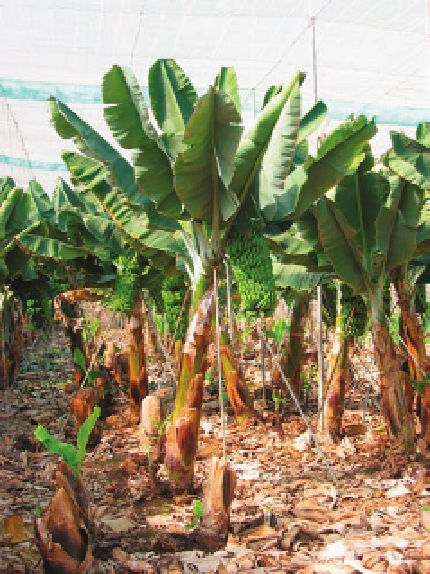Agriculture Reference
In-Depth Information
The covering of greenhouses with a
screen (net) instead of with a plastic film,
is a recent introduction at low latitudes. It
limits the radiation and the outside wind
without increasing the temperature. In
very arid or desert areas, the insulation
that the greenhouse provides in relation
to the outside environment (which is very
dry and hot) represents a different con-
cept to that of conventional protected
cultivation, as it provides for an increase
in the ambient humidity and a reduction
in the temperature, provided the crop is
well irrigated. This has prompted talk
about the 'oasis effect' (Sirjacobs, 1988;
Photo 4.1).
In a greenhouse, the reduction of the
radiation with respect to the open air means
there is a decrease in the irrigation require-
ments (as evapotranspiration decreases),
which together with a significant increase
in yield results in a much more efficient use
of the irrigation water (Stanghellini, 1992).
This is relevant in regions with scarce water
resources.
In tropical and subtropical regions of
high rainfall, the 'umbrella effect' predomi-
nates in greenhouses (Photo 4.2), because
the primary purpose of their use is to avoid
the harmful effects of frequent and heavy
rains over the crops. Here the greenhouse
effect is normally undesirable, as the natu-
ral thermal conditions are sufficient, or even
excessive, for the development of the crops
(Garnaud, 1987).
4.3
Geographical Production Areas
In the past, greenhouses were located near
cities, were the produce was destined for
sale. Until the middle of the 20th century,
transport difficulties confined the use of
greenhouses to the areas adjacent to the cen-
tres of consumption.
Nowadays, the location of the produc-
tion areas is influenced, mainly, by climate
conditions and by the type of species to be
cultivated, which determine the costs and
quality of the yield, as well as the transport
costs to the consuming markets. Other tech-
nical factors (e.g. availability and quality of
irrigation water, soil characteristics) and
socio-economic factors (e.g. commercial
channels, levels of technology in the area,
financing possibilities, communication and
electricity infrastructures, farm size, availa-
bility of inputs for horticultural production)
also have an influence at a time marked by
the internationalization of trade and, in gen-
eral, the globalization of the economy.
The displacement of greenhouse pro-
duction areas that occurred during the
last decades of the 20th century are a good
example of this. In Europe, greenhouse
vegetable production has moved from the
north to the Mediterranean area (Photo 4.3),
where the better climate conditions in
autumn and winter enable production at
notably lower costs, without using heating
(Tognoni and Serra, 1988, 1989). Similar
movements occurred in the USA when car-
nation cultivation partly moved to
California and Florida (with a better cli-
mate) from the traditional production areas
(East Coast) and from Colorado, where an
important sector had emerged due to its
Photo 4.1.
A banana crop grown in a greenhouse.
In very arid or desert areas, the greenhouse
generates a certain 'oasis effect'.

